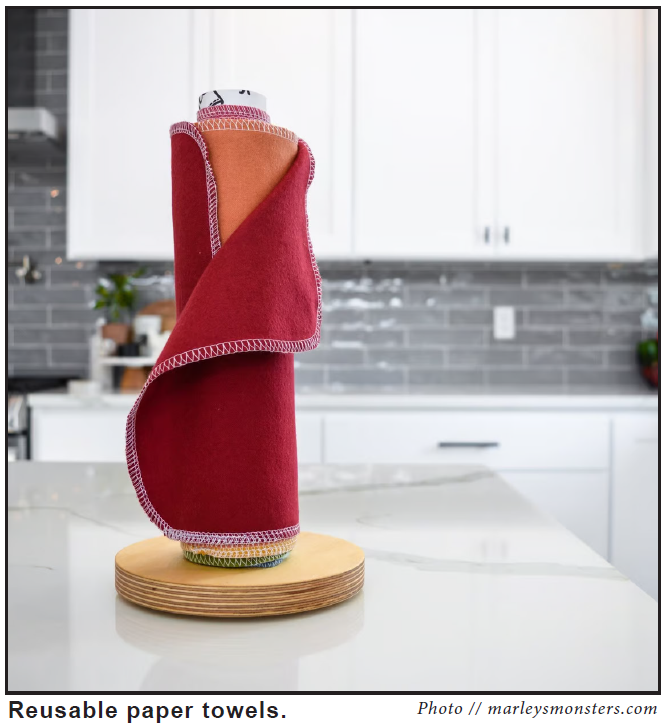
By: Mira Costello
Editor-in-Chief
I usually hate New Year’s resolutions – there’s too much pressure to make them, and it feels like setting yourself up for failure. This year, though, I decided to take my general trying-to-be-greener habit and make it something real. While this includes lots of things – shopping small, buying secondhand, composting and more – one of my hardest and most important resolutions has been to stop using so much plastic.
Here’s what I’ve done so far.
Switching from liquid laundry detergent to detergent sheets
Liquid detergent is expensive, and it comes in a big plastic bottle. I switched to laundry detergent sheets that dissolve in the washer and come in a recyclable box. Unlike laundry pods, the sheets don’t have a plastic casing, which also helps me avoid microplastic pollution. These run about $10-$15 for 64 loads’ worth.
Prioritizing plastic-free produce
Fresh produce is a privilege, and if frozen or canned fruits and vegetables are better for your lifestyle, you’re making a sustainable choice – avoiding food waste. (Staying within your budget is also part of sustainability!) When I buy fresh produce, I seek out options that aren’t pre-bagged or in a plastic clamshell, and I use reusable produce bags instead of the plastic ones at the store. I got mine at Trader Joe’s for $6.
Reusable bags, always
To match my produce bags, I always use reusable grocery bags. Mine are old, and I don’t remember where I got most of them, but they do the trick! Secondhand tote bags are a great option. What they don’t tell you, though, is that you can actually bring anything as your grocery bag. Got a backpack? Bring a backpack. Got a pillowcase? You know the drill. Function beats form every time.
Ditching plastic food containers
Besides produce, I’ve tried to limit other foods that come in plastic – for example, Celestial Seasonings doesn’t use any plastic for their tea, and I found oats that come in a cardboard carton rather than a plastic bag. I’ve also moved away from Ziploc bags, cling wrap and plastic Tupperware, opting for glass jars instead (I just wash and reuse my pasta sauce, pickle and jam jars), to avoid both single-use plastic and microplastic exposure.
Eating less fast food
This one has been good for my wallet and my resolution. Almost all fast food comes with some sort of plastic – utensils, packaging, styrofoam and straws are common culprits (even the non-plastic packaging can’t be recycled because it’s soiled with food). Many restaurants now offer a no-utensil option for pickup orders, so that’s also a good place to start!
Using reusable cloth paper towels
While paper towels obviously aren’t plastic, they do come wrapped in it (and they make waste, too). I switched to cloth towels that roll up just like paper towels; mine are the UNPaper Towels from Marley’s Monsters. They ship them with no plastic, too. These are more of an investment, but they cost the same as about 20 regular rolls and will last much longer than that. I’ve found them easy to use and wash, and now I only use paper towels when I really need to.
Prioritizing sustainable menstrual products
Menstrual products create lots of single-use plastic waste. The plastic-free and organic versions of single-use products tend to be very expensive, too. The most convenient and sustainable options I’ve found are period underwear and washable cloth products, especially the ones from Lil Helper, which are affordable. Menstrual cups, while made of plastic, are also more sustainable than single-use products.
Downsizing my cosmetics
Almost all cosmetic and hygiene products are packaged in plastic, and it’s okay that many of them are necessities. I’ve pared my skincare routine down to the essentials, which for me are moisturizer and sunscreen. I haven’t needed to purchase any makeup so far, but if I do, I’ll seek out plastic-free options like Elate Cosmetics and River Organics. I’ve found out that plastic-free toothpaste and deodorant aren’t a good fit for me, which is why I’ve sought out other swaps. It’s important to personalize your sustainability habits to your life in a way that makes it easier, not harder!
Avoiding synthetic fabrics
One of my other goals is not to buy any clothes this year. If I have to, I’ll steer clear of the sneaky plastic in materials like nylon, polyester, acrylic, spandex and fleece. Not only do these materials degrade after a few washes, but they contribute to plastic pollution when they are thrown away by consumers or by companies as overstock. While all textiles have a massive environmental impact, cotton and denim are probably the most accessible plastic-free options. Others include linen, wool, silk and canvas.
Shopping in bulk with my own containers
You might notice that much of this list centers around my grocery routine, because there is near infinite plastic to be found in most stores. To minimize it, one option is bulk buying. Most bulk stores carry products like spices, flour and sugar, coffee, cereals, oats, soaps, pasta, nuts and many more – just bring your own container, fill it up and pay by weight. Purple Porch Food Co-op at 123 Hill St. in South Bend has a bulk department with over 100 products. (Plus, who doesn’t want their cereal in a cute mason jar instead of a garish cardboard box?)
Bonus: just buying less stuff!
This speaks for itself: inevitably, the more stuff you buy, the more plastic you buy. Use what you already have, keep it intentional and remember that the most sustainable purchase is the one you don’t make.